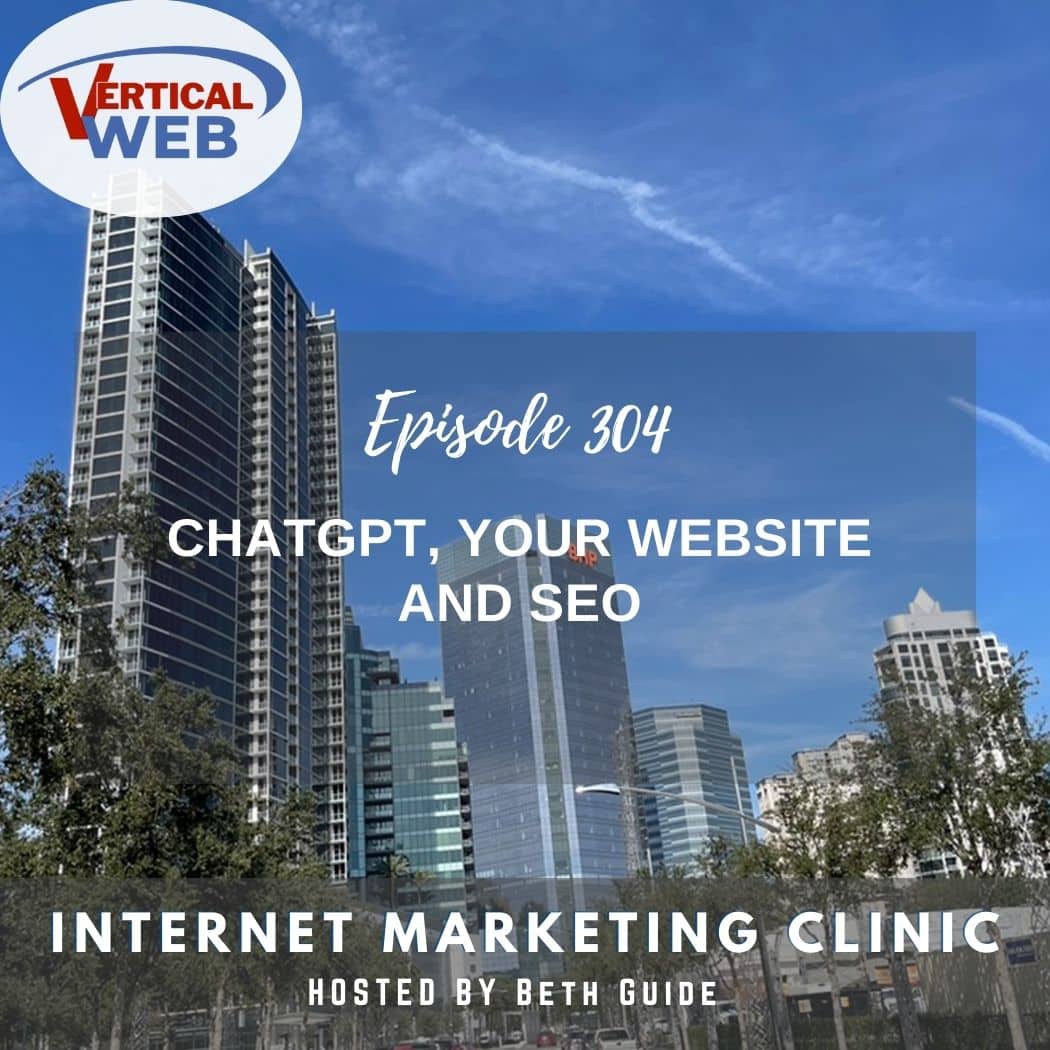Subscribe to Our Podcast Apple Podcasts | RSS
For anyone who has been around the Internet Marketing Clinic for a while, knows we always try to stay ahead of where the road goes. AI tools have turned 2023 on its ear, and it is not even March. In this episode of the IMCH, we are taking an in-depth look at how to balance AI tools like ChatGPT and your website, content or SEO efforts. There is a lot of very dangerous misguided implementations ideas so we wanted try and stay ahead of it and let you know what we think you should be doing and how to used this very powerful tool, but do it in a manner that you don’t blow yourself up.
Do not copy AI-generated content and paste it into a website
Before you run off to ChatGPT and generate your entire website from scratch – stop. In our practice, we’ve already seen business owners attempt this with disastrous results. And that is what I keep seeing and hearing. It feels like, right or wrong everyone things they found the secret to creating mass pages to place on their website and that is just not true.
Google has upped the useful content penalty possibly taking aim at cut-and-paste AI-generated content, and the search engine is getting better and better at detecting it. There are hundreds of AI writers out there, but it’s unlikely that any of them could evade Google’s AI detection for long.
Why is Google seeking and destroying AI-generated pages? Because AI can’t produce a page that’s as well-written, organized and detailed as a human expert-created page. At least for now, human experts provide more value with their writing than ChatGPT or other AI tools.
This is because AI content generators work by scraping and distilling what’s already on the internet. Google doesn’t want a web full of copycat content – it wants originality. And it wants original thinking because that’s what users want. From Google’s perspective, AI content generators have the potential to pollute the internet with identical pages and damage the user experience.
On the other hand Google also is okay with AI content if they add to the web. If there is solid new information it more than likely won’t get dinged. But you have to committed to making sure the information is not just spun and put out on the website.
There are a few more problems with AI content generation, that you need to be aware of to avoid a penalty.
- Superficial reasoning and knowledgebase – ChatGPT and AI writers can spit out tons of information with every prompt, but because this information is sourced from thousands of sites – many of them low quality – the information tends to be superficial. This problem is more pronounced for niche topics and industries, where there are fewer inputs for AI to work with.
- Confusing conceptual linking and writing flow – AI also has trouble determining which pieces of information link together and how they should link together. Us humans do this naturally when we speak, because our communication is predicated on exchanging and responding to information provided by other people.That’s why AI writers tend to go off-track with topics or repeat themselves throughout an article. You won’t find an AI linking an insightful first-hand experience with the topic at hand. That kind of web-like conceptual thinking is still beyond the reach of AI.
- Difficulty with proper punctuation and grammar – Curiously, AI writers also seem to have the occasional issue with word order, sentence structure or punctuation. The longer the content, the more likely these mistakes are to emerge in a piece of AI content.
It may not be long before these kinks are hammered out, but for now, the above should give business owners pause before they go all-in on AI. Doing so could wipe out your traffic now or in the future, when Google retroactively applies penalties for AI content-generation methods.
All of this is subject to change as Google implements GoogleBard, its own AI Tool
Everything in this article could become obsolete overnight – thus is the nature of AI development. The technology is evolving extremely fast and no one (not even industry experts) knows how Google intends to leverage AI for search ranking purposes.
What we do know is that Google has its own AI in development named Bard, and it’s planned for release “soon.” In Google parlance, “soon” could mean months from now or minutes from now. When it is released, it will likely shake up the digital marketing industry even more.
What can AI tools like ChatGPT paired with Jasper AI and then paired with a Human do for content marketing?
Okay, now that we’ve laid out the risks of AI content, we’ll address how to minimize those risks and make the technology work for business owners. After all, while Google doesn’t want AI cut-and-paste jobs, it has admitted that it’s okay with AI content, as long as it provides value and meets the search engine’s content standards.
Getting AI content up to that standard, though, that’s the trick.
We’ve experimented a bit with ChatGPT and AI content writers like Jasper, and there’s an opportunity here to create high quality, expert level content using both. Specifically, ChatGPT can be used to develop outlines for your content pages, while Jasper can do some of the actual writing. The emphasis is on the word “some,” however. At this point, we recommend an 80/20 mix between human-created and AI-created writing on any particular page.
A recommended step-by-step guide on using AI to generate content for your website
So there’s room for AI in your content generation processes, but you’ll need to be careful. First, we’ll create an article outline in ChatGPT. Here’s how to do that:
- Go to the OpenAI website, where ChatGPT is the featured piece of software.
- Create a free account – there is a premium account option, but it only provides faster answers from the chat bot.
- Now, you should be in the chat app and ready to provide ChatGPT with a prompt. First, ask it to list the keyword you’ll need for your page. For example, “tell me the keywords I need for a page about small business accounting services.” ChatGPT will instantly spit out the high value words to place in your content.
- You’ve got the keywords, now you need the outline. Ask ChatGPT what topics should be included in your article. For example “what should be included in an article about small business accounting services?” ChatGPT will list the high-level ideas that should be addressed in your article.
- You can continue this process to go further in depth. Once ChatGPT suggests the high-level topics that should be in your article, you can ask follow-up questions to dive deeper into those ideas. For example “compare accrual accounting and cash-based accounting for small businesses.” By asking more and more detailed questions, you’ll be able to create a more focused, thorough outline.
Once you have this outline in hand, you can stop here with the AI and start writing your page. For many, the outline is the tough part, and just getting that worked out can speed things along. However, if you want, you can take this outline and develop it into content.=
You’ll need a high quality AI writing tool to begin with. We recommend Jasper because it’s the best we’ve found, but it can be expensive for small business owners. If you do invest in Jasper, you can use it like ChatGPT by entering a prompt.
Using the example from above, you could enter “write about the differences between accrual account and cash-based accounting.” Jasper will immediately generate an answer, which could be several paragraphs long.
Don’t take this copy and paste it into your website!
Your job, as the subject matter expert, is to review the content and do the following:
- Identify and correct any errors – and there will likely be some
- Update any outdated information – and there will likely be some
- “Humanize” the content and add your own original experiences and insights
- Reorder and link the content sections, if necessary
- Fix any grammatical or punctuation errors and there will be plenty
My page on Google Penalty Repair is a great example of how to mix the balance or mix mentioned above, and we recommend starting and ending the page with from-scratch content that you write. In effect, you’re “massaging” the content so that it doesn’t read like an AI wrote it, or flow like an AI thought it up. Your voice as the writer and expert should still clearly come through. The article I produced was 80/20 in favor of human touch despite using AI to build the entire page.
AI will be the focus for digital marketers in 2023, so stay up to date here on any developments
All of this is still developing in real time, and it’s possible that this article will be completely off the mark by the end of the year. For now, though, the above practices are what we consider to be the best practices for using AI in your content marketing.
If the AI picture changes, and boy will it, we’ll record our findings and report them here. Check in with us throughout the year to ensure your content remains in lockstep with Google’s standards.
- Google Leaks and What They Mean for SEO and Small Business from an SEO Expert - July 19, 2024
- SEO Hacks: Easy Ways to Win at SEO - June 8, 2024
- Last Call for Todays Class Get Your Business On the Map – - May 22, 2024


